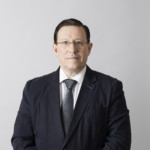Summary
Russia’s re-elected president speaks about the need to achieve a “breakthrough”. But his only realistic goal is perpetuation of the regime.
Those who watched Vladimir Putin’s inauguration ceremony on May 7 must have paid attention to the TV cameras’ preoccupation with two people on the front row: Dmitry Medvedev, the longest-serving Prime Minister of post-Soviet Russia, and former German Chancellor Gerhard Schröder. The first figure symbolized the loyalty of Russia’s power vertical and the country at large to Putin. The second was there to demonstrate that the relationship with the West is still manageable.
Arguably, this is exactly how the situation appears to Putin and his entourage.
The March elections were won with a record result: 77% of the votes were cast for Putin, which amounted to almost 52% of the whole electorate. The opposition can still stage street protests, but the numbers are much smaller than a year ago, and nothing compared to the winter of 2011–12. Factions within the ruling elite compete with each other, which makes the regime less monolithic, but they are neither willing nor able to challenge Putin’s position as a balancer and a figure that legitimizes their own access to power and benefits.
There are good reasons to believe that the symbiotic relationship in Russia’s top echelons will continue running smoothly. Market-oriented technocrats (it would be a mistake to call them “liberals”) are capable of finding the money. If need be, some savings can be made, while the retirement age and taxes may be raised. But a high level of military expenditure and large infrastructure projects will be maintained – not least because the appetites of Kremlin-friendly oligarchs must be satisfied.
Meanwhile, the notorious siloviki – the power structures – will observe their part of the deal and oppress the dissenters. The protests of May 5, when more than 1,600 people were detained, including teenagers and even children, showed that the repressive machine is as resolute in using violence as ever. Furthermore, it is now openly engaging non-legalized paramilitaries to beat protesters in front of the cameras, in order to intimidate people even more.
But maybe the use of undue force will not be needed after all. With oil at almost 80 USD per barrel and rising, Russia’s reserves approaching half a trillion dollars, inflation at historic lows, a resumption in growth, and so forth, one may well ignore sporadic revelations of social and economic problems.
Foreign policy helped to mobilize domestic support for the regime, and if that had a price, it was worth paying. But even without a connection to domestic politics, the Kremlin may claim success on the external front. The use of military force in Ukraine and Syria ruled out the perspective of further EU and NATO enlargement in the post-Soviet space, while making Russia a key player in the Middle East again. A “pivot to China” may bear less fruit than Moscow would have wanted, but it still counts on Beijing’s solidarity in its conflict with the West. As for the latter, what matters for Moscow is not the rhetoric, not whether diplomats are expelled (or recalled) – only to be replaced (or returned) within weeks – but whether trade is growing and pipeline projects like Nord Stream 2 are moving forward, which has been the case so far. New potential US sanctions may be painful indeed, but they may still be avoided.
If this is what Putin envisages, it would be very logical to simply continue the old policies. Of course, all the relevant rhetoric about the need to achieve a breakthrough “in all spheres of life” will be delivered for those in the country who wish the authorities to embark on “changes”. But the vision is to act without touching the economic and political fundamentals.
For example, on his inauguration day Putin set a goal for Russia to become the world’s fifth largest economy by 2024. Today, in nominal dollars, Russia holds the 13th position. Even in purchasing power parity terms it would still need to overtake Germany, so the task is undoubtedly ambitious. However, the plan implies reaching the objective primarily with the help of state funds, without liberating private initiatives within the country or attracting foreign investment, which makes it utterly unrealistic. It even conflicts with Russia’s own official growth forecasts.
Equally unrealistic is the idea of increasing life expectancy in Russia during the next presidential term from the current 73 years, which is less than in China, to 78. When Russia has to use surrogates like palm oil on a massive scale to replace the sanctioned western food products, or when it discusses sanctioning the import of western pharmaceuticals, the national health situation is not very likely to improve qualitatively.
At the same time, the realism in planning may not be required. For as long as Russia’s political institutions are what they are, there is no political responsibility for non-delivery. Andrei Illarionov, Putin’s former economic advisor, who later became extremely critical of Russia’s leader, has calculated that it is the seventh time, starting from 2007, that Putin has talked about the “fifth economy”. What is more, the task of “catching up with Portugal” announced at the very beginning of Putin’s first term, as far as GDP per capita is concerned, has not been fulfilled as yet, despite the colossal oil profits of the 2000s.
All in all, the outlook for Russia’s immediate future does not engender much expert debate. Putin 4.0 is a promise of more of the same. The system has guaranteed his unchallenged continuation in power, and that may be the only criterion for success that is important to him. As long as the system performs this function, he will see no reason to dismantle or reform it.

